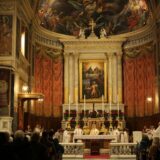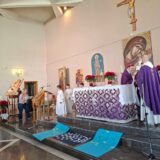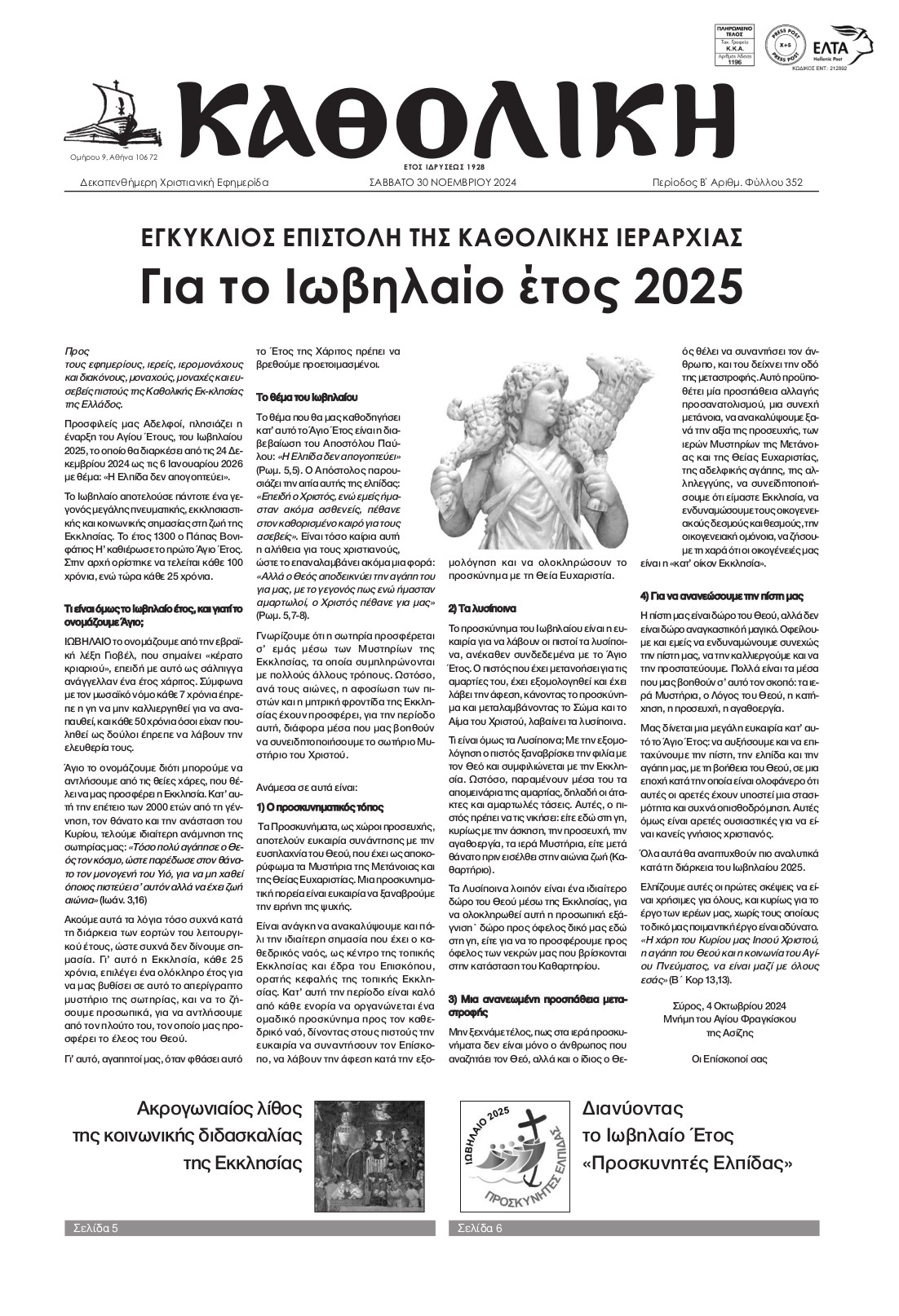BYZANTINE & CHRISTIAN MUSEUM Athens,
Wednesday 6 October 2021
“The Battle of Nafpaktos and its aftermath in the world of the East and West”
The Battle of Lepanto is one of the most famous but also one of the fiercest battles in world history. It was the result of a long series of political, economic and religious compromises and negotiations, it took place on 7 October 1571 and was undoubtedly the most important military event of the 16th century with the greatest impact on the Mediterranean region.
“‘A huge flame’, Braudel writes, ‘which we can still see shining despite the distance of more than four centuries in time’.
The fall of Constantinople in 1456 and the gap that had been created between the eastern and western worlds allowed the Ottomans to expand to all points on the map, and by the mid-16th century they had dominated all areas of the former Byzantine Empire. The Sultans, set out to capture all the fortified positions of the Crusaders and the Order of St. John of Jerusalem as they retreated, and in 1522 they captured Rhodes. A few years later, in 1565, the Knights Hospitallers repelled them from the walls of Malta, but in 1570 the Fourth Venetian-Turkish War broke out, which would mark the dramatic capture of Cyprus.
Venice, having long been aware of the entanglement between the Kingdom of France and the Northern Countries, on the one hand for the control of trade routes and on the other hand for matters relating to the religious rivalries caused by the Reformation, and England, whose Queen Elizabeth had been declared deposed and excommunicated by the Catholic Church a few months earlier, asked the Pope to undertake a campaign to establish a front with Spain, with the ultimate aim of securing the straits of the eastern Mediterranean. The Venetians, desperately trying to organise their possessions in Crete, Corfu, the north continental coast, Naxos and Tinos, which for six months would be subjected to a fierce siege by the Ottoman fleet, such that it would leave behind scorched earth, thousands of dead and even more prisoners. The Ottoman fleet concluded its campaign with the capture of Cyprus and on 5 September 1570 it occupied Nicosia and a few days later the Turks invaded Famagusta. The conquest of the city was accompanied by atrocities against the Venetian garrison and civilians and by looting. The fear of Ottoman expansion further west alarmed the Spaniards, who had known Islamic domination of the Iberian Peninsula, and the Venetians, who wanted to regain their trading posts from the eastern Mediterranean to the Adriatic.
The coalition of Christian and mainly Catholic countries was a difficult affair, since even in the face of the coming Ottoman invasion, all prejudices between the two protagonists had to be overcome and guarantees and compensations had to be given by the Pope for the role and hegemony of each power, but also for the distribution of the booty later, while negotiations for the participation of Portugal, the German Empire and the Kingdom of France, which was bound by a commercial alliance with the Sultan, were tough. The Sacred Anti-Turkish Coalition, the Sacra Liga Antiturca, which was signed on 20 May 1571 after much effort by Pope Pius V, was an invitation to unite the papal fleet with those of other European kingdoms and the Italian states, so that united and forgetting old disputes, they could oppose their civilisation with that of Asia, which was increasingly invading the West.
The gathering of the Christian fleet took place in Messina, Sicily. There also arrived the ships from Crete and the Ionian Islands, the papal fleet, the Genoese, the ships of the Duke of Parma, the Knights of Malta and the Spanish-Venetian forces, which, under the command of Don Juan of Austria, illegitimate son of Emperor Charles V, awaited the signal for departure. The allied ships hoisted the flag of the Cross, while the Greek ships raised banners with the images of their patron saints. They were all united by the banner of the Holy Alliance sent to them by the Pope, with Christ crucified between the Apostles Peter and Paul. With stops at Corfu, Igoumenitsa, Parga and Kefalonia, they sailed off the Corinthian Gulf, near the Echinades Islands, where the Ottomans had begun to gather under the command of Kapudan Pasha Ali Zazé muezzin. Despite the Ottomans’ apparent superiority in numbers of ships and men, the small number of cannons burdened them with a strong disadvantage that would prove to be decisive for the outcome of the battle.
The Ottomans began to create with their ships a semicircle,( as a crescent), obviously expecting to outflank the enemy with its two ends, hitting him from the side. The crews fought with characteristic bravery, and the conflict between the two forces continued as fiercely as the hatred that simmered in the bowels of the thousands of enslaved Christian rowers who were tied to the Turkish holds. Four hours had elapsed since that terrible conflict began, and so many were the dead on both sides that, as it was recorded, “the galleys seemed to rest on the bodies floating in the water.” On the contribution of the Greeks to the success of the naval battle , the Venetian historian Parouta states: “much praise is due to the Italians who did not surpass the Spaniards in valour. The glory of the Greek fighters , overshadowed them, surpassed all others in daring, bravery and discipline, by their exploits turned the scales in favour of the Christians,. More than 9000 Greeks, mainly Cretans, but also islanders and Heptanesians, offered their ships and their fortunes, making the naval battle of Nafpaktos stand out from the other conflicts of the time, not only for the size and the thousands of dead and wounded, but also for the intensity of the battle.
The aftermath and legacy of the battle in modern historical research offers multiple translations. The author of Don Quixote, Miguel de Cervantes Saaverda, who fought and was wounded that day, will write a little later: “It turned out that the Turks were not invincible”, to which the Papal Archbishop Marcantonio Collona would add “at last we have learned that the Turks are people like us”. In this climate of enthusiasm, the greatest credit for the victory was given, and not without reason, to Pope Pius V, who not only organised and financed this campaign, but succeeded in maintaining a balance between forces often antagonistic and unwelcome to his interests. His last words, rather prophetic, shortly before his death on 1 May 1572 were as follows: “You will not easily find one whose greatest desire is the elimination of the enemies of the faith of Christ and the cross… But by the blood of Christ, I beg you to elect as soon as possible a man of zeal to my place, and not to choose him on the basis of worldly criteria alone. The year is already advanced. Whatever is to be done must be done soon, and if the year passes without some notable action, the people will lose their enthusiasm, and our work and our great victory will remain fruitless.”
And unfortunately, it did, as his death was followed by extreme political and religious events and religious wars in France and the Nordic countries. But also in our wider neighbourhood, with the decimated Ottoman fleet fleeing southwards, with ships rudderless and half-burnt lying stranded on the coast and falling into the hands of the victors, and with hundreds of Ottomans trapped on the continental coasts, the Christian forces, instead of indulging in the pursuit of the Turks and the escalation of the war, with the aim of liberating the unredeemed areas and especially Cyprus, were reduced to the distribution of spoils. At the same time, hundreds of Greeks who had been liberated or escaped from the dungeons seized the weapons that the Ottomans had abandoned in order to take revenge for the barbarities committed in Corfu and Famagusta in the previous months, hoping in vain that this victory would be the beginning of the liberation of the Balkan peninsula from the Turkish yoke. When news of the outcome of the naval battle reached the mainland, the rebels spread from Mani to Monemvasia and even threatened Mystras. Small rebellions occurred in the western Peloponnese, in Patras and Aegialia, and later continued in the western Peloponnese. The uprising continued in Epirus, while Greek clergymen urged the faithful to revolt in Thessaly, Euboea, Serres, Thessaloniki, and even on the peninsula of Mount Athos. Neither the islands of the Aegean nor the cities on the coast of Asia Minor were unmoved at the news of victory. This tidal wave of various uprisings almost shook the Ottoman authorities’ hold on mainland of Greece. The escalating tension alarmed the High Gate, but the loose unity and backsliding that pervaded the Holy Coalition, despite the late actions of John of Austria to arm the Greeks with munitions from the warehouses of Milan, deprived our country of a historic opportunity for its liberation that was to be delayed for more than two and a half centuries. The Greek population of the Turkish-occupied Greek regions, who had pinned great hopes for their liberation on Western intervention, found themselves defenceless against the Turkish counter-attack, which manifested itself in an organised manner in the following period. It has been estimated that the victims of the purges, in which the Turks advanced at that time, exceeded 20,000 souls, while many more were captured.
Nevertheless, in a broader historical context Lepanto still had important implications: The constant wars, the destruction of the fleet, and the cost of the naval battle to the Ottoman Empire contributed to the eruption of a major fiscal crisis that plagued it for at least a decade. At the same time, in the history of naval warfare, the Battle of Lepanto marked the last major engagement, fought in the Western world, between rowing ships, signalling the rise of sailing ships in sea battles, as well as new operational and military tactics. After all, as the Sultan said, in justifying the defeat at Nafpaktos, all the aliens achieved was to shave a few hairs from his beard, and they were to grow back very quickly. Soon, the Ottomans built a new fleet and began to strengthen their defences so that within four years, aided by the peculiar socio-geographical context and economic expediency, they re-established an expansive social and political structure, which was maintained with all its contradictions until the 19th century. At the level of claims and international relations, the Spanish penetration of the Greek territory was a matter of concern for Venice, which sought ways of reaching the Greek population, creating a network of spies, in which great scholars and ecclesiastical figures of the time were involved. On the other hand,
Many Aegean islands built small ships and established synafia and consortia, taking on missions of Turkish merchants in high-risk maritime areas in the Eastern Mediterranean, experiencing an economic boom. By the end of the 17th century, almost the entire trade of the Aegean and the coast of Asia Minor was in the hands of Greek merchants, making, as has been written, the Battle of Nafpaktos the starting point for the development of merchant shipping in Greece, which gradually led to the economic control of the Ottoman Empire by the Romans (Greeks).
Despite the lukewarm efforts of Pius V’s successor, Pope Gregory XV, to renew the action of the Holy Coalition, the Holy Alliance had become a shadow of unholy agreements with the Venetian Republic, unable to cope with the enormous expenses required by the war conflicts, it was forced on 7 March 1573 to sign a peace treaty with the Turks, which provoked strong reactions on the part of its allies. From then on, the Ottomans suspended the relations they had developed with the Habsburgs, with whom they had concluded a peace treaty as early as 1568, and turned diplomatically towards France, England and the Netherlands, powers that would dominate the Mediterranean commercially and politically in the centuries to come.
The promotion of the naval battle to a battle between good and evil, albeit in a context of idealization, demonstrated once again the need, both Eastern and Western, to place their hopes and attribute the victory in the intercession of some heavenly power. So, before the noise and excitement of the victory had even died down, all those who had participated in it and those who had heard of its magnitude attributed this result to a miracle of the Virgin Mary. Dozens of churches were built to honour Our Lady of Victory, Our Lady of Iceta, Our Lady of the Bound, Our Lady of the Liberator, Our Lady of Lepanto, Our Lady of the Holy Rosary, which Pope Pius V himself urged the Christian powers to recite. Even in Protestant countries the victory was remembered as a great triumph for Christianity, as the salvation of the Christian world from a barbarian invader. And to further emphasize the heroism and sacrifice of the Christian crews, the Ottomans were described in chronicles and art as heroic and worthy opponents. Besides, it would be naive to claim that the Ottomans were lacking in bravery or that they were made up of troops of barbaric and uncivilised conquerors. With intelligent and worthy admirals and a civil administration largely composed of subjects of the former Byzantine provinces, like the Holy Coalition, they gave this conflict an ideological character of a defensive holy war. As has been rightly said, ‘reality was confused with myth in the realm of motives, and this was of great importance to two opponents who were equally convinced that they were fighting for a just cause’. And even if Pope Pius V was still extolling the outcome of the naval battle at every tone as a victory of Christians over Muslims, that is, as a victory of good over evil and as a victory of civilization over barbarism, modern research now provides us with the evidence to know that “the Ottomans of the 16th century were several times much more tolerant than their modern opponents.”
The alliance of so many disparate forces, my dear friends, and their victory over the Ottomans, who were considered invincible at sea until then, inspired, even at that time, important artists, who created an exuberant artistic expression, representing phases of the naval battle and celebrating the bravery of its protagonists. It is a period, moreover, when Rome, Venice and Spain, which played a leading role in this naval epic and where the leading artists of the time were active in their territories, were looking for ways to reflect their contribution to the great historical events of their time and to promote the glory of their rulers. Mannerism gave way to the Baroque and complex allegorical scenes emerged with patron saints and idealised figures representing the powers involved. Artists such as Paolo Caliari, the so-called Veronese, Andrea Michieli known as Vicentino, Tiziano Vecelio, Caravaggio, Tommaso Dolabella and the Spanish Juan Luna, the Genoese Luca Cambiaso, Antonio Danti and Giorgio Vasari at the Vatican Apostolic Palace and others, Maltese, Flemish, Dutch, German and Danish, left iconic works. Great sculptors and engravers, through their engravings and the commemorative medals they issued, also made it possible to disseminate this historical testimony with a considerable density of data and information. But also in the field of poetry and literature, there was a remarkable production, not only by chroniclers of the period, Ionian and Cretan, but also by younger people who were moved by the echoes of the naval battle. Among them, the father of Spanish literature, Cervantes, who fought and was wounded in the battle, occupies a dominant position,
, as he wrote,he lost his left hand for the glory of his right. According to tradition, Cervantes was taken to Corfu and was temporarily hospitalised in the hospice kept by the Augustinian monks in the church of the Annunciation of the Virgin Mary in Annunziata. And with them, the Greek painters and hagiographers who depicted the Battle of the Bulge, drawing on information and testimonies from the survivors and from the chronicles of the time. Dominikos Theotokopoulos of Crete (El Greco), Antonios Vassilakis, the chosen Aliense, originally from Milos, Velissarios Korentsis or Corenzio, from Kyparissia, but also the great post-Byzantine hagiographers such as the Cretan painters Georgios Klontzas and Michael Damaskinos, portrayed the Christian victory allegorically, as did all the great painters of their time.
This, my sisters and brothers, is the echo of the battle, events, traditions, devotions, passions and omissions, but also memories that are sometimes confirmed and sometimes not, with a historical timelessness that is more relevant today than ever and therefore must never be forgotten. For this is the today’s anniversary event, and all the previous and future commemorations that will be organised on the basis of this historic event. But I think of the words written by the French philosopher Maurice Halbvaks, known for his contribution to the field of collective memory, that ‘it is the social groups that determine what is “memorable” and also the way in which we will keep it in our memory’ and as the Battle of Nafpaktos has remained in the consciousness of the Western world as a powerful symbol of historical continuity and the reconstruction of collective and national identity, Today I do not want to remember this event and this anniversary only for the military feats, or only for the bravery of those who fought and those who were killed, or only for the pain of the prisoners who were burned and drowned tied to the holds of the galleys, nor for the honours, portraits and glories of the great protagonists. Today my mind races to a black and white image, that of St. Pope Paul VI, the peacemaker. It was Tuesday, July 25, 1967, when during an official visit to Turkey to meet Ecumenical Patriarch Athenagoras, he was received by the Turkish President in Istanbul. During his reception, he presented the Turkish President with the Banner of the Ottoman Flag of 1571, which was kept as a trophy for four centuries in the Vatican Museums. “The return of this historical relic, which has been in Rome since the distant times of the Battle of Lepanto,” said the diminutive Pontiff, “is a symbolic gesture, but a very pleasant one for us, as we want to publicly affirm that the divisions and threats of the past are now dead and that all that remains in our hearts is the hope of becoming, for all peoples, messengers of peace and of maintaining, at last, relations characterized by the most sincere and cordial friendship.”
May Our Lady of the Rosary intercede for this.
Thank you
Spyros P. Gautsis






